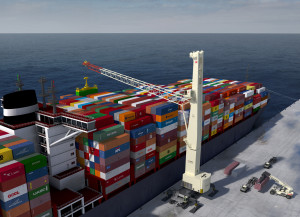Terex Gottwald model 8 mobile harbour crane with new variant
 Terex Port Solutions (TPS) has responded with a new variant of its successful diesel-electric Terex Gottwald Model 8 mobile harbour crane to meet increasing demand from terminal operators for cargo-handling machines for loading and unloading vessels with a loading capacity of more than 8,800 standard containers. These terminal operators require professional and mobile large-sized cranes, able to handle 20 container rows across and up to nine containers stacked on the vessel’s deck, quickly and economically. Furthermore, these container-handling machines need to accommodate for special quay conditions.
Terex Port Solutions (TPS) has responded with a new variant of its successful diesel-electric Terex Gottwald Model 8 mobile harbour crane to meet increasing demand from terminal operators for cargo-handling machines for loading and unloading vessels with a loading capacity of more than 8,800 standard containers. These terminal operators require professional and mobile large-sized cranes, able to handle 20 container rows across and up to nine containers stacked on the vessel’s deck, quickly and economically. Furthermore, these container-handling machines need to accommodate for special quay conditions.
New machine derived from modular crane system
The latest new development from TPS that meets the needs of the market is based on the existing Model 8 G HMK 8410 two-rope crane variant from the Generation 5 Terex Gottwald crane modular system. Compared to the present variant, the new G HMK 8412 has a higher tower with a correspondingly higher boom pivot point and a tower cab featuring a crane operator eye level of 43 m. The maximum outreach of the crane has been extended by 3 m compared to the G HMK 8410 and comes to 61 m. The crane has a particularly powerful lifting capacity curve, offering terminal operators 24 per cent greater capacity in the end range of its outreach, which means a lifting capacity of 50 t even at maximum radius. The crane, with a lifting capacity of 41 t under spreader, is even capable of serving three container bays next to each other effectively, even in the 20th row, without having to be travelled alongside the vessel. As with the majority of Terex Gottwald cranes, the G HMK 8412 is fitted with state-of-the-art three-phase drive technology that provides greater benefits for operators with regard to upkeep and maintenance.
Compact, easily maneuverable chassis for demanding quays
Compared to the present G HMK 8410, the 12-axle G HMK 8412 crane also comes with a modified chassis design that combines proven and new technology. With this innovative design, the TPS travel gear and propping system on the chassis are geometrically decoupled, which, even with a crane of this size, leads to a relatively compact and thus short type of construction, which in turn has a particularly beneficial effect on the maneuverability of the crane in the terminal.
The travel gear of the G HMK 8412 includes a total of four proven 3-axle arrangements with a distance of 1,650 mm from axle center to axle center. In addition, the distance between one 3-axle arrangement and the next has been increased by 1,000 mm from 1,650 mm to 2,650 mm, thus improving how the load is distributed to individual fields of the quay structure. This is particularly important given that many existing quays, which were not originally designed for cargo handling cranes of this scale, now are used for operating more powerful and thus heavier cranes. To improve the transversal load distribution on the quay, the G HMK 8412 is fitted with a broader axle track than the G HMK 8410 to provide greater safety when the crane is travelled. As is customary for TPS, the propping system of the crane consists of the Terex Gottwald H-shaped stabilizer system with a propping base of 13 m x 15 m. When the crane is propped, four 2 m x 6.5 m stabilizer pads distribute the weight of the crane and cargo to the quay structure. As a further option, depending on quay conditions, a four double-hinged arrangement can also be used.
Modular design principle for TPS harbour cranes accelerates development processes
Dr. Mathias Dobner, Vice President Engineering, Systems & Automation TPS, emphasizes: “Our mobile harbour crane range of the current Generation 5 includes three crane families and eight crane models, ranging from the entry to the high-performance crane for all types of terminals, applications and vessels. With the new G HMK 8412 crane, we are demonstrating once again how quickly we are able to develop machines on the basis of our modular design principle to meet rapidly changing market conditions including the need to serve new types of vessels and ready them for the market.”






